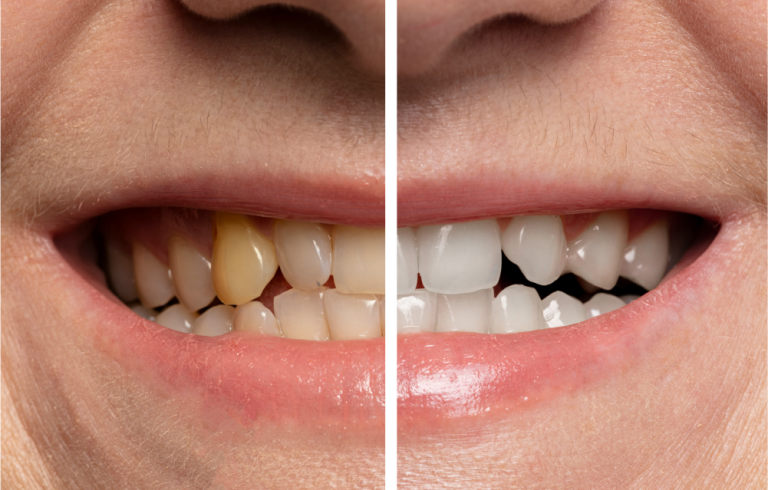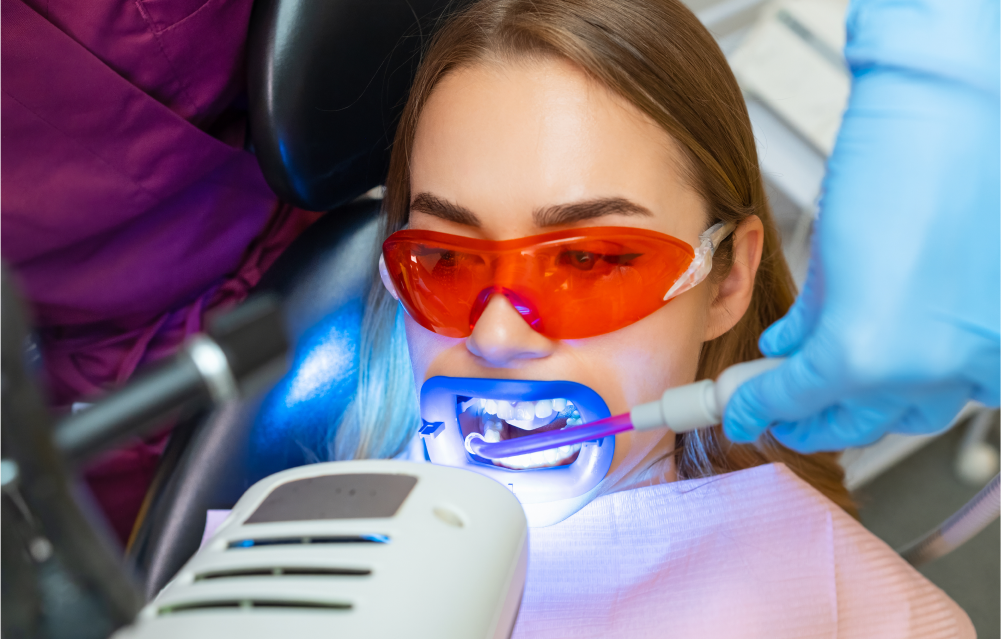What’s With Those Pesky Yellow Canines?
15 Apr 2024
Why Are My Canines Yellow?
Understanding the Causes of Yellow Teeth
Have you ever wondered why your canine teeth (the middle 4 teeth and incisors on both top and bottom) look more yellow than others? There are several reasons for this, and it’s not just about how well you brush your teeth.
The color of your teeth naturally varies because of what’s inside. Beneath the hard, white, outer shell –enamel– there’s a softer layer called dentin. Dentin is naturally yellow and becomes more visible as enamel gets thinner. Since enamel on canines is thinner than on other teeth, these teeth often look yellow before other teeth do.
Your daily habits may also play a role. Drinking coffee, tea, or red wine can stain your teeth over time. Smoking is another big cause of yellow teeth. Even some mouthwashes and medications can lead to discoloration if used regularly.
Lastly, genetics influence how thick your enamel is and the natural color of your dentin. Some people just have whiter teeth naturally because they have thicker enamel or lighter dentin.
So, if your canines are yellow, it’s a mix of the anatomy of your teeth, lifestyle, and genetic makeup. While you can’t change your genetics, you can influence the other factors. Regular dental care and being mindful of what you consume can help manage yellowing.
Exploring Enamel Thickness and Its Impact on Tooth Color
Did you know that the thickness of the enamel on your teeth can affect their color? Enamel is the hard, protective outer layer of your teeth. Its thickness varies from tooth to tooth and from person to person. Few have perfectly uniform teeth in color or shape. In fact, modern dentures, crowns, and veneers are made not to match and with imperfections to appear more natural.
Thicker enamel tends to make teeth look whiter because it does a better job of hiding what’s underneath. When enamel is thin, more of that yellow dentin shows through, giving the tooth a yellower appearance.
Different types of teeth have different amounts of enamel. For example, your molars usually have thicker enamel than your canines, which is why canines often look more yellow. Also, as we age, our enamel wears down, making teeth look darker or more yellow over time. It’s a natural process that shouldn’t be feared.
The thickness of your enamel is largely determined by genetics, so some people naturally have whiter teeth just because they have thicker enamel. However, enamel can also be worn down by things like acidic foods and drinks, hard brushing, or grinding your teeth.
Knowing how enamel thickness can be eroded can help you take better care of your teeth. Protect your enamel by avoiding harsh abrasives and acidic foods, and by practicing gentle brushing.

How to Whiten Yellow Canines (Teeth)
Looking to brighten your yellow canines? There are several ways to achieve a whiter smile, both at home and with professional help.
At-Home Remedies:
- Whitening Toothpaste and Mouthwashes: These products contain mild abrasives and chemicals that help remove surface stains. They are great for daily maintenance and minor discoloration.
- Baking Soda and Hydrogen Peroxide: You can make a paste with baking soda and a few drops of hydrogen peroxide. Brush with this mixture a few times a week to help reduce yellowness. Just be gentle to avoid damaging your enamel.
- Whitening Strips and Gels: Available over the counter, these products are applied directly to the teeth and are more potent than toothpastes or mouthwashes. However, if used incorrectly, these chemicals can harm your gums and soft tissues. A consult with your dentist is advised before going this route. Experience has shown us that these products have a poor rate of return.
- Fruit Peels: Rubbing your teeth with the inside of a banana peel or orange peel can supposedly whiten teeth too. These peels contain compounds that some believe help reduce yellowing. The science hasn’t been done to justify buying fruit simply for its aesthetic uses AND these fruits are both high in sugar and acids that contribute to enamel erosion and cavities! This home remedy is not endorsed by Greenspoint Dental.
- Apple Cider Vinegar: Using diluted apple cider vinegar as a mouthwash can help whiten teeth. However, it should be used sparingly as vinegar can soften teeth if used too frequently.
Professional Treatments:
- Bleaching: This is one of the most common professional whitening methods. Dentists use stronger bleaching agents than those found in at-home kits. The results are faster and more pronounced. *Note: this is not the same chlorine bleach used in cleaning products.
- Laser Whitening: A professional technique where a laser is used to speed up the bleaching process. It offers quick results and significant whitening in just one session. Greenspoint Dental uses Zoom! laser technology for the best results.
- Veneers: For teeth that are resistant to bleaching, veneers can be an option. These are thin covers that go over the front of your teeth to give them a whiter appearance.
Choosing Between DIY and Professional Whitening: Deciding between home remedies and professional treatment depends on the severity of your tooth discoloration, timeline, and budget. Home methods are budget-friendly and good for slight yellowing, but professional treatments are better for deeper stains and quicker results.
Whichever method you choose, make sure to follow the product instructions or your dentist’s advice to protect your teeth and achieve the best results.
How can you keep your teeth from yellowing?
Want to keep your teeth looking bright and healthy? Preventing yellowing before it starts is often easier than trying to remove stains later. Here are some simple lifestyle changes and home remedies that can help you maintain a whiter smile.
Lifestyle Changes to Prevent Tooth Yellowing:
- Watch What You Eat and Drink: Coffee, tea, red wine, and dark sodas are famous for staining teeth. Try to limit these beverages or use a straw to minimize contact with your teeth. Also, foods with strong colors, like berries or curry, can contribute to yellowing.
- Quit Smoking: Tobacco is one of the major culprits behind tooth discoloration. Quitting smoking or using tobacco products can significantly help in keeping your teeth whiter. The rest of the tissues in your mouth, throat, and lungs would also appreciate it.
- Improve Your Oral Hygiene: Brush twice and floss daily. Good oral hygiene helps remove plaque and stains before they set in. Consider using a whitening toothpaste for added stain removal. While they are not powerful enough to reverse damage, they can aid with maintenance between professonal treatments.
By incorporating these tips into your daily routine, you can help prevent your teeth from yellowing and maintain a brighter, healthier smile. Remember though: some degree of discoloration is natural as we age, and perfect whiteness is not always the norm for healthy teeth.

Professional Dental Treatments for Severe Tooth Discoloration at Greenspoint Dental
When home remedies and over-the-counter products aren’t enough to tackle severe tooth discoloration, professional dental treatments can provide a more effective solution. At Greenspoint Dental, we offer several advanced treatments designed to restore the natural whiteness of your teeth, tailored to meet your specific needs.
Laser Teeth Whitening: One of the most advanced whitening methods available today is laser teeth whitening, which we proudly offer at our clinic. This procedure uses a strong bleaching gel that is activated by laser light to speed up the whitening process. It’s particularly effective for significant discoloration and can achieve dramatic results in just one session, making it a popular choice for those looking to brighten their smile quickly. Check out the results people get when using Zoom! laser whitening.
Custom Bleaching Trays: For those who prefer a more gradual approach, our custom bleaching trays might be the ideal solution. Unlike over-the-counter kits, these trays are designed specifically for your mouth, providing comfort and ensuring even coverage of the whitening agent. You can use them at home but with professional-grade results, and with the guidance of our dental team to monitor your progress. *Note: this is not the same chlorine bleach found in cleaning chemicals.
Porcelain Veneers: For teeth that are resistant to whitening procedures, porcelain veneers offer a beautiful alternative. These thin, custom-made shells are attached to the front of your teeth, instantly transforming your smile by covering stains, chips, or gaps. Veneers are long-lasting and crafted to match the natural appearance of your enamel, providing a solution that is both cosmetic and durable.
Dental Bonding: Another option for discolored teeth is dental bonding, which involves applying a tooth-colored resin to the tooth surface. This method can correct discoloration that is too stubborn for bleaching, and it also helps reshape teeth or fill in gaps. Bonding is a cost-effective and minimally invasive procedure that can be completed in a single visit.
At Greenspoint Dental, our goal is to help you achieve a smile that you’re proud to show off. Each of these treatments can be tailored to meet your unique dental needs, ensuring the best possible results. During your consultation, we’ll discuss which options are best suited to your situation and what you can expect in terms of outcomes.
Embrace a Brighter Smile with Greenspoint Dental
Achieving and maintaining a bright, healthy smile is an important part of your overall health and confidence. While there are many home remedies and over-the-counter solutions that can help with mild discoloration, severe tooth discoloration often requires professional intervention. At Greenspoint Dental, we are committed to providing you with the highest quality dental care tailored to your specific needs.
Whether you’re interested in exploring advanced whitening treatments, considering veneers, or simply looking for a reliable dental care provider, we invite you to take advantage of our special offer. As a new patient at Greenspoint Dental, you’re eligible for a free dental exam and x-ray. This is a great opportunity to discuss your dental health concerns with our experts, learn about suitable treatment options, and take the first step toward the brilliant smile you deserve.
Don’t let tooth discoloration hold you back. Contact Greenspoint Dental today to schedule your free exam and x-ray, and let us help you achieve the radiant smile you’ve always wanted. Your journey to a brighter, healthier smile begins here!
Related Blog Articles